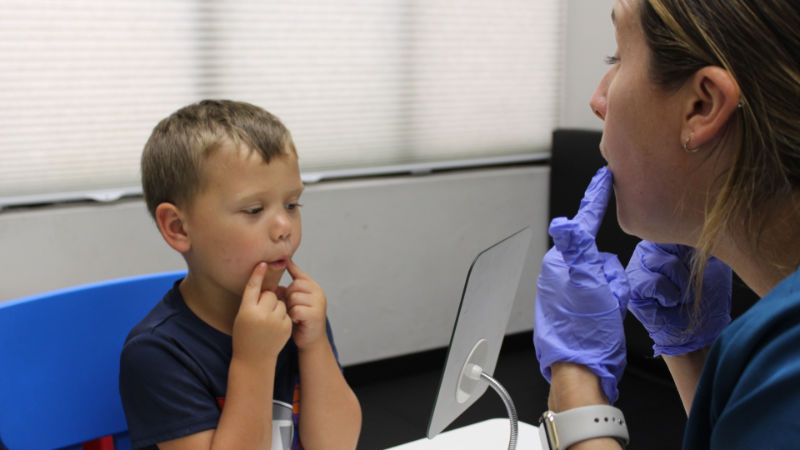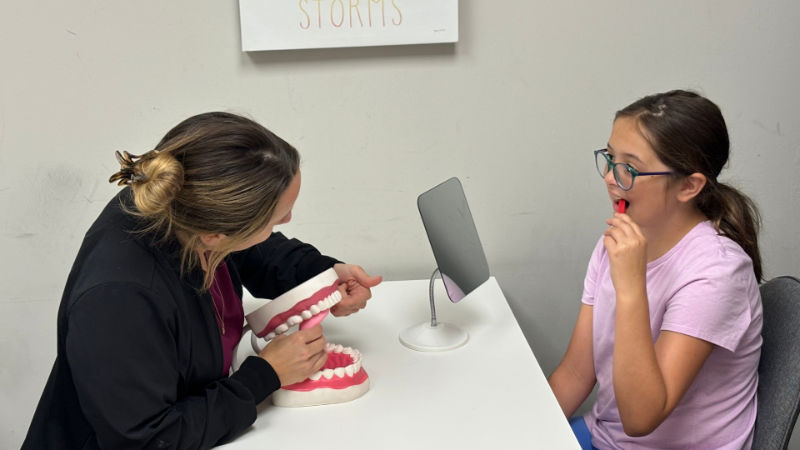Orofacial Myofunctional Therapy
What is Orofacial Myofunctional Therapy?
Speech disorders like lisps or pronouncing /r/ as /w/ often coincide with other issues. In our practice, we’ve noticed links between these speech challenges and problems such as picky eating, sleep disturbances, attention difficulties, snoring, and even the need for dental work.
The common thread? Tongue rest position. When the tongue rests properly behind the teeth, suctioned to the roof of the mouth, with good nasal breathing, many of these symptoms can improve. This optimal position supports palatal expansion, facial growth, and maintains an open airway for better oxygen flow to the brain. It also strengthens the muscles needed for clear speech and diverse eating habits.
This insight has transformed our approach. After years of treating patients with limited success, we’ve seen remarkable progress using Orofacial Myofunctional Therapy (OMT). Many of our patients now achieve their goals within about 9 months.
OMT works best for children and adults who can follow directions and commit to daily exercises. Sometimes, we collaborate with ENTs or specialized dentists for comprehensive care. It’s important to note that without this commitment and willingness to work with other professionals, OMT – and indeed, traditional speech therapy – may not yield the desired results.
By addressing the root cause of speech and most feeding issues through OMT, we aim to provide lasting solutions rather than temporary fixes. This approach helps prevent lifelong struggles by tackling the underlying problems head-on.
Symptoms of OMDs:
- Picky eating or difficulty with certain food textures
- Poor sleep, snoring, or mouth breathing
- Speech issues, such as lisps or difficulty with /r/ sounds
- Tongue thrust Swallow
- Needing a palate expander
- Needing orthodontic work
- Oral habits like thumb sucking or nail-biting
- Jaw pain or clicking

Tongue Tie Treatment: Before and After Care
When dealing with a tongue tie, whether in children or adults, proper therapy is crucial both before and after the release procedure. Think of it like physical therapy for a knee surgery – preparation and follow-up care are key to optimal results.
Before the Release: We focus on strengthening the muscles around the tongue. This preparatory work ensures that once the tie is released, the tongue has the strength to maintain its new, correct position.
After the Release: Post-procedure therapy is equally important. We guide you or your child in learning:
- Proper tongue resting position
- Correct swallowing techniques
- Improved speech patterns
- Effective chewing methods
These sessions help retrain habits that may have developed over years of working around the tongue tie.
Wound Care: We also provide essential guidance on wound care to prevent re-attachment of the released tie, ensuring the procedure’s long-term success.
Our comprehensive approach to tongue tie therapy aims to maximize the benefits of the release procedure, promoting better oral function and overall well-being.
Thumb Sucking and other Oral Habit Elimination Program
Habits like thumb sucking, prolonged pacifier use, and extended bottle feeding can significantly impact a child’s oral development. These practices often lead to a low tongue resting position, affecting speech, airway function, oral structure, sleep quality, and eating habits. Ideally, pacifier use should end around 6 months, and bottle feeding by 12 months to promote proper oral development.
Our specialized program offers a structured approach to breaking these habits. We work with you and your child to create a personalized plan, provide ongoing support, and teach alternative coping strategies. This program requires commitment, but with dedication and our expert guidance, we can help your child develop healthier oral habits for better overall development.

